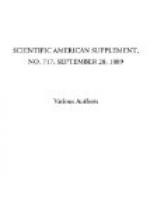In almost all investigations which the physicist carries out in the laboratory, he has to deal with and to measure with accuracy those subtile and to our senses inappreciable forces to which the so-called laws of nature give rise. Whether he is observing by an electrometer the behavior of electricity at rest or by a galvanometer the action of electricity in motion, whether in the tube of Crookes he is investigating the power of radiant matter, or with the famous experiment of Cavendish he is finding the mass of the earth—in these and in a host of other cases he is bound to measure with certainty and accuracy forces so small that in no ordinary way could their existence be detected, while disturbing causes which might seem to be of no particular consequence must be eliminated if his experiments are to have any value. It is not too much to say that the very existence of the physicist depends upon the power which he possesses of producing at will and by artificial means forces against which he balances those that he wishes to measure.
I had better perhaps at once indicate in a general way the magnitude of the forces with which we have to deal.
The weight of a single grain is not to our senses appreciable, while the weight of a ton is sufficient to crush the life out of any one in a moment. A ton is about 15,000,000 grains. It is quite possible to measure with unfailing accuracy forces which bear the same relation to the weight of a grain that a grain bears to a ton.
To show how the torsion of wires or threads is made use of in measuring forces, I have arranged what I can hardly dignify by the name of an experiment. It is simply a straw hung horizontally by a piece of wire. Resting on the straw is a fragment of sheet iron weighing ten grains. A magnet so weak that it cannot lift the iron yet is able to pull the straw round through an angle so great that the existence of the feeble attraction is evident to every one in the room.
Now it is clear that if, instead of a straw moving over the table simply, we had here an arm in a glass case and a mirror to read the motion of the arm, it would be easy to observe a movement a hundred or a thousand times less than that just produced, and therefore to measure a force a hundred or a thousand times less than that exerted by this feeble magnet.
Again, if instead of wire as thick as an ordinary pin I had used the finest wire that can be obtained, it would have opposed the movement of the straw with a far less force. It is possible to obtain wire ten times finer than this stubborn material, but wire ten times finer is much more than ten times more easily twisted. It is ten thousand times more easily twisted. This is because the torsion varies as the fourth power of the diameter. So we say 10 x 10 = 100, 100 x 100 = 10,000. Therefore, with the finest wire, forces 10,000 times feebler still could be observed.
It is therefore evident how great is the advantage of reducing the size of a torsion wire. Even if it is only halved, the torsion is reduced sixteenfold. To give a better idea of the actual sizes of such wires and fibers as are in use, I shall show upon the screen a series of such photographs taken by Mr. Chapman, on each of which a scale of thousandths of an inch has been printed.




